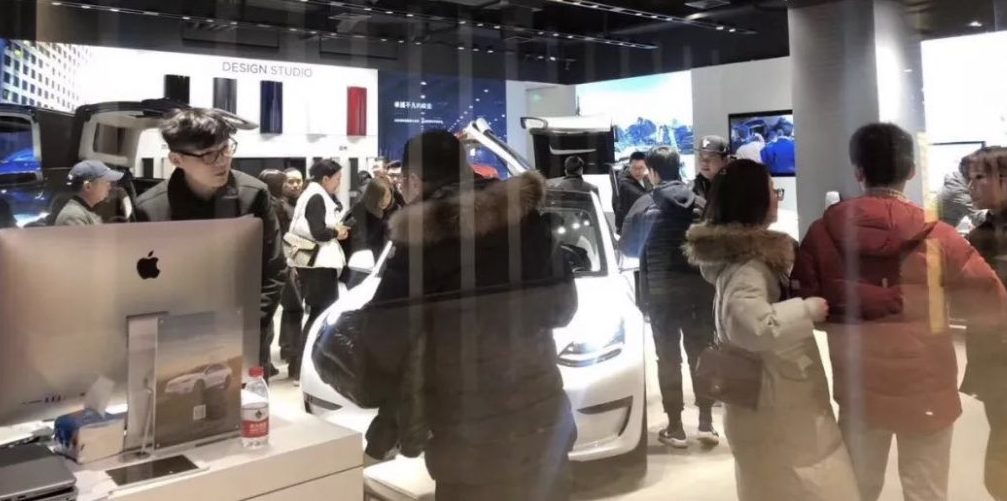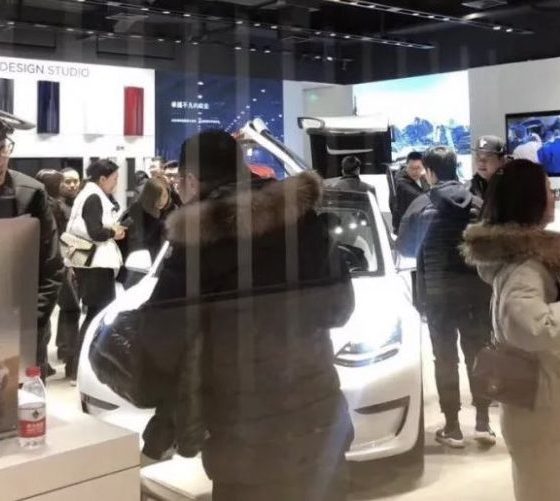

Investor's Corner
Tesla stores in China are reportedly seeing a tsunami of Model 3 orders
As China gears up for Model 3 deliveries to begin in the country, the interest and anticipation for the electric car among reservation holders and potential buyers appear to be reaching a fever pitch. If reports from Chinese social media are any indication, it seems that waves of Model 3 orders are already hitting the country’s stores.
For the Model 3 to be successful in China, the electric car must be good enough to attract a lot of attention and demand from the car-buying public. Recent reports from Chinese social media users suggest that consumers are indeed interested in the Model 3. During the past few days alone, social media posts from the region noted that some Tesla stores ended up having system issues due to the influx of orders they are receiving for the Model 3.
Tesla Model 3 sales went insane the last few days in different cities of China.
Some locations reported stores’ systems were down & wireless CC machines went out of battery due to too many orders. At least 20 orders per store in a day(weekdays)$TSLA #Tesla #Model3 #TeslaChina pic.twitter.com/srD17N96ze
— vincent (@vincent13031925) February 19, 2019
Other posts from the area were equally optimistic. A Weibo user who took the electric car for a test drive on February 13, for one, observed that her sales representative’s mobile phone was receiving notifications for Model 3 orders every 6-10 minutes. “During the chat with the Tesla specialist, I observed that his cellphone popped three times with new Model 3 orders in about 20-30 mins. In other words, about 6-10 minutes, there is a Model 3 sold in that location,” 老徐是我呀, the Weibo user, wrote.
Last week, reports emerged stating that the Glovis Symphony, a cargo ship loaded with China-bound Model 3, has arrived at the Tianjin Port. Other ships loaded with the sedan, such as the solar-hybrid car carrier, Emerald Ace, are expected to arrive in China within the next weeks as well, as noted in a report from local news outlet CCTV. With these factors in mind, it appears that Model 3 deliveries in China would likely begin very soon.
Photos taken today at Tianjin Free Trade Zone near Xingang Port, Tianjin, China. Since arriving on Monday this is the very first photos of @Tesla Model 3 Shipment to China. Photo Credit to 李大锤同学微博 via @Weibo#Tesla #TeslaChina #China #Model3 #GlovisSymphony #特斯拉 $TSLA pic.twitter.com/Z0pFUIZbwo
— Jay in Shanghai 电动 Jay 🇨🇳 (@JayinShanghai) February 15, 2019
It remains to be seen if the Model 3 would be as big of a success in China as it was in the United States, where its disruption was so notable that it became the country’s best-selling luxury vehicle in 2018. Nevertheless, the reception that the car has received from Chinese auto media and social media users appears to be mostly positive so far. In a review of the Model 3 Performance by Chinese auto group Know the Car, for one, it was concluded that the electric car could outperform rival premium, high-performance sedans such as the BMW M3 and the Mercedes-AMG C63 at the racetrack.
Tesla has been pushing some offers to make the Model 3 an attractive purchase for Chinese buyers. Earlier this month, for example, Tesla opted to include Enhanced Autopilot, an add-on that previously cost 46,300 yuan (around $6,800), as standard for all Model 3 purchases in the country.

Investor's Corner
Tesla stock closes at all-time high on heels of Robotaxi progress

Tesla stock (NASDAQ: TSLA) closed at an all-time high on Tuesday, jumping over 3 percent during the day and finishing at $489.88.
The price beats the previous record close, which was $479.86.
Shares have had a crazy year, dipping more than 40 percent from the start of the year. The stock then started to recover once again around late April, when its price started to climb back up from the low $200 level.
This week, Tesla started to climb toward its highest levels ever, as it was revealed on Sunday that the company was testing driverless Robotaxis in Austin. The spike in value pushed the company’s valuation to $1.63 trillion.
Tesla Robotaxi goes driverless as Musk confirms Safety Monitor removal testing
It is the seventh-most valuable company on the market currently, trailing Nvidia, Apple, Alphabet (Google), Microsoft, Amazon, and Meta.
Shares closed up $14.57 today, up over 3 percent.
The stock has gone through a lot this year, as previously mentioned. Shares tumbled in Q1 due to CEO Elon Musk’s involvement with the Department of Government Efficiency (DOGE), which pulled his attention away from his companies and left a major overhang on their valuations.
However, things started to rebound halfway through the year, and as the government started to phase out the $7,500 tax credit, demand spiked as consumers tried to take advantage of it.
Q3 deliveries were the highest in company history, and Tesla responded to the loss of the tax credit with the launch of the Model 3 and Model Y Standard.
Additionally, analysts have announced high expectations this week for the company on Wall Street as Robotaxi continues to be the focus. With autonomy within Tesla’s sights, things are moving in the direction of Robotaxi being a major catalyst for growth on the Street in the coming year.
Elon Musk
Tesla needs to come through on this one Robotaxi metric, analyst says
“We think the key focus from here will be how fast Tesla can scale driverless operations (including if Tesla’s approach to software/hardware allows it to scale significantly faster than competitors, as the company has argued), and on profitability.”

Tesla needs to come through on this one Robotaxi metric, Mark Delaney of Goldman Sachs says.
Tesla is in the process of rolling out its Robotaxi platform to areas outside of Austin and the California Bay Area. It has plans to launch in five additional cities, including Houston, Dallas, Miami, Las Vegas, and Phoenix.
However, the company’s expansion is not what the focus needs to be, according to Delaney. It’s the speed of deployment.
The analyst said:
“We think the key focus from here will be how fast Tesla can scale driverless operations (including if Tesla’s approach to software/hardware allows it to scale significantly faster than competitors, as the company has argued), and on profitability.”
Profitability will come as the Robotaxi fleet expands. Making that money will be dependent on when Tesla can initiate rides in more areas, giving more customers access to the program.
There are some additional things that the company needs to make happen ahead of the major Robotaxi expansion, one of those things is launching driverless rides in Austin, the first city in which it launched the program.
This week, Tesla started testing driverless Robotaxi rides in Austin, as two different Model Y units were spotted with no occupants, a huge step in the company’s plans for the ride-sharing platform.
Tesla Robotaxi goes driverless as Musk confirms Safety Monitor removal testing
CEO Elon Musk has been hoping to remove Safety Monitors from Robotaxis in Austin for several months, first mentioning the plan to have them out by the end of 2025 in September. He confirmed on Sunday that Tesla had officially removed vehicle occupants and started testing truly unsupervised rides.
Although Safety Monitors in Austin have been sitting in the passenger’s seat, they have still had the ability to override things in case of an emergency. After all, the ultimate goal was safety and avoiding any accidents or injuries.
Goldman Sachs reiterated its ‘Neutral’ rating and its $400 price target. Delaney said, “Tesla is making progress with its autonomous technology,” and recent developments make it evident that this is true.
Investor's Corner
Tesla gets bold Robotaxi prediction from Wall Street firm
Last week, Andrew Percoco took over Tesla analysis for Morgan Stanley from Adam Jonas, who covered the stock for years. Percoco seems to be less optimistic and bullish on Tesla shares, while still being fair and balanced in his analysis.

Tesla (NASDAQ: TSLA) received a bold Robotaxi prediction from Morgan Stanley, which anticipates a dramatic increase in the size of the company’s autonomous ride-hailing suite in the coming years.
Last week, Andrew Percoco took over Tesla analysis for Morgan Stanley from Adam Jonas, who covered the stock for years. Percoco seems to be less optimistic and bullish on Tesla shares, while still being fair and balanced in his analysis.
Percoco dug into the Robotaxi fleet and its expansion in the coming years in his latest note, released on Tuesday. The firm expects Tesla to increase the Robotaxi fleet size to 1,000 vehicles in 2026. However, that’s small-scale compared to what they expect from Tesla in a decade.
Tesla expands Robotaxi app access once again, this time on a global scale
By 2035, Morgan Stanley believes there will be one million Robotaxis on the road across multiple cities, a major jump and a considerable fleet size. We assume this means the fleet of vehicles Tesla will operate internally, and not including passenger-owned vehicles that could be added through software updates.
He also listed three specific catalysts that investors should pay attention to, as these will represent the company being on track to achieve its Robotaxi dreams:
- Opening Robotaxi to the public without a Safety Monitor. Timing is unclear, but it appears that Tesla is getting closer by the day.
- Improvement in safety metrics without the Safety Monitor. Tesla’s ability to improve its safety metrics as it scales miles driven without the Safety Monitor is imperative as it looks to scale in new states and cities in 2026.
- Cybercab start of production, targeted for April 2026. Tesla’s Cybercab is a purpose-built vehicle (no steering wheel or pedals, only two seats) that is expected to be produced through its state-of-the-art unboxed manufacturing process, offering further cost reductions and thus accelerating adoption over time.
Robotaxi stands to be one of Tesla’s most significant revenue contributors, especially as the company plans to continue expanding its ride-hailing service across the world in the coming years.
Its current deployment strategy is controlled and conservative to avoid any drastic and potentially program-ruining incidents.
So far, the program, which is active in Austin and the California Bay Area, has been widely successful.








